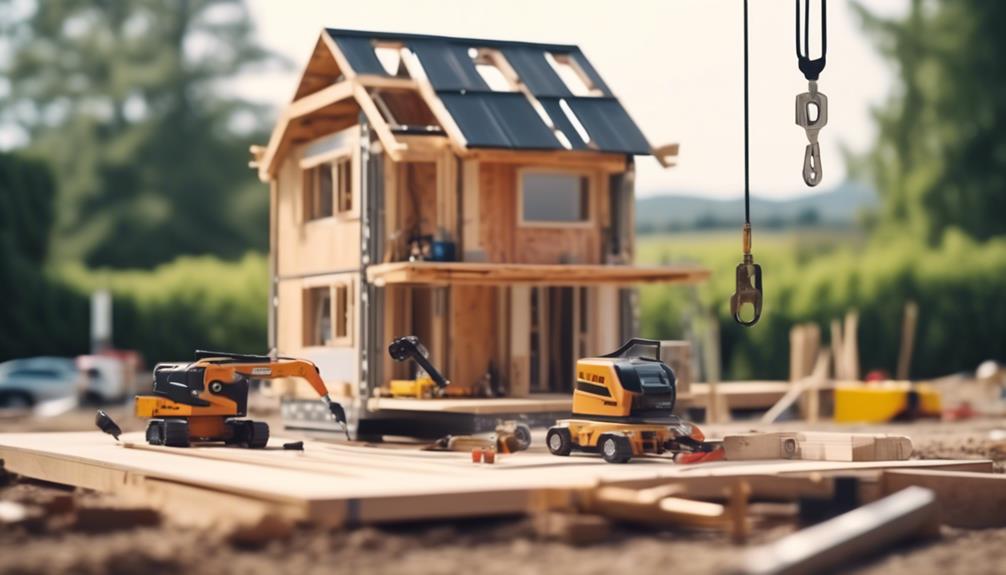In an age where you can have anything from a pizza to a pet elephant delivered to your door, you might think adding a tiny home to your property would be just as easy. Unfortunately, it's not as simple as clicking a button, but you're in luck because navigating the labyrinth of zoning laws and building codes is not insurmountable.
You'll need to check whether your slice of Texas heaven is zoned for such an innovation—a tiny house might not be so tiny when it comes to legalities. As you sketch out your dream miniature abode, remember that securing the necessary permits is a step you can't afford to skip unless you fancy a tête-à-tête with a local inspector.
With a measured approach, you'll find out just what it takes to transform your expansive property into a haven of minimalism and efficiency. So, let's take a closer look at the intricacies of this process, as there's much more to uncover about the journey from grand vision to tiny reality.
Key Takeaways
- Research and understand local zoning laws and regulations for tiny homes before starting the project.
- Design your tiny home with space efficiency and compliance in mind, considering multi-purpose furniture and durable materials.
- Secure all necessary permits and ensure compliance with building and zoning codes before beginning construction.
- Prepare the site properly, including soil stability assessment, utility connections, and adherence to code requirements.
Assessing Zoning Laws
Before adding a tiny home to your property, you'll need to carefully check your local zoning ordinances to ensure they permit such structures in your area. Regulations can vary greatly, so it's crucial to dive into the specifics of local planning and zoning.
Start by consulting your city or county's development code, which will detail the zoning laws applicable to tiny houses—whether they're on wheels or a permanent foundation.
You must also assess zoning laws related to the placement and construction standards. Check your location guidelines for any particular requirements you must meet, and don't hesitate to reach out to your local zoning authority. They can provide authoritative advice on building codes and zoning, helping you navigate the innovative journey of integrating a tiny home into your living space.
Designing Your Tiny Home
When designing your tiny home, every square inch counts, so it's essential to focus on creating a space that's both functional and sustainable. Here's how to ensure your design meets that standard:
- Space Efficiency: Opt for multi-purpose furniture and built-in storage to maximize your living area. Remember, Specific building code requirements may dictate the minimum square feet of floor space.
- Sustainability: Use durable, low-maintenance materials and integrate energy-efficient features to lower your ecological footprint while living in tiny house communities or as standalone ADUs.
- Compliance: Familiarize yourself with Tiny Home Rules, including zoning code rules and utility requirements, especially if you're considering a tiny house on wheels. This will guide your design process and ensure legal adherence.
Securing Necessary Permits

Before you add a tiny home to your property, it's essential to identify local zoning restrictions that dictate where and how you can build.
You'll need to navigate the permit application process, which varies depending on whether your tiny home is a permanent or temporary structure.
Consult with your local planning office or a land use attorney to ensure you meet all requirements and secure the necessary permits.
Identify Zoning Restrictions
To ensure your tiny home addition adheres to local laws, you'll need to consult your area's zoning ordinances and obtain the necessary permits. Zoning regulations can be intricate, and they vary widely from one city to another. They dictate what you can build and where, impacting your project's feasibility.
Here's what you should do:
- Research Local Zoning Laws: Investigate your city's specific zoning regulations related to residential property. Check if tiny homes are categorized under Accessory Dwelling Units (ADUs) and note the square feet of floor restrictions.
- Understand Building Codes: Ensure that your tiny home meets local building safety standards and building code requirements, particularly if it's on foundations.
- Secure Permits: Obtain all necessary permits before construction; consider professional help, like a land use attorney, for a smooth process.
Permit Application Process
Navigating the permit application process requires submitting detailed plans and documentation to your local building department to ensure compliance with zoning and building codes. To adhere to building safety and the building code requirements that govern the construction of tiny homes, you'll need to submit a comprehensive permit application package. This should include architectural plans that detail the minimum square footage and other specifications demanded by your local zoning ordinance.
Before you proceed, check with the local planning office to grasp site-specific regulations, especially if your property falls outside city limits. They offer the guidance necessary to navigate the complexities of local building codes.
Preparing the Site
Ensure you've thoroughly reviewed local zoning ordinances and building codes to identify the perfect spot on your property for your tiny home, taking into account factors such as setbacks and utility connections.
When preparing the site:
- Consult with home builders specialized in building a tiny home to assess soil stability and land topography, ensuring your tiny house types legalized for permanent residence can be safely constructed on your property.
- Adhere to code requirements for tiny homes, obtaining structures validated by the local authority; you'll need to submit detailed plans and may need site inspections.
- Establish utility connections according to regulations for tiny homes, which might include innovative off-grid solutions if standard connections aren't feasible or desired.
Building or Installing

Once you have completed the site preparation, it's time to delve into the actual building or installation process of your tiny home, adhering strictly to the relevant safety standards and zoning laws.
If you're building a permanent foundation, ensure your houses meet local building codes. In Texas, utility connections and code compliance are non-negotiable for a Texas Tiny Home.
For those opting for mobility, tiny homes on wheels must follow ANSI regulations, which might save you from personal property tax. Always check with your city's planning office to clarify laws and secure the necessary permits. Remember, in cities like Houston, wheels classify your home as a recreational vehicle, subjecting it to different requirements.
Build with confidence by staying informed and compliant.
Utility Connections and Services
You'll need to establish utility access for your tiny home, ensuring it's equipped with water, sewage, and electricity to make it a functional living space. Coordination with service providers is crucial; they'll guide you through the process of connecting your tiny home to the necessary utilities in compliance with local codes.
Keep in mind local zoning regulations and development codes may impact how and where you can connect your services.
Establishing Utility Access
To establish utility access for your tiny home, start by contacting local providers to navigate the intricacies of connecting to water, electricity, and sewer services. Here's what you need to consider:
- Regulations and Compliance: Check the regulations surrounding tiny houses within city limits. Ensure your tiny house on a permanent foundation meets National Safety Institute (ANSI) standards, akin to a recreational vehicle.
- Connection Costs: Be prepared for the financial aspect; utility connections can impact your property taxes. Get estimates and plan your budget accordingly.
- Logistics and Planning: Understand the logistics of establishing utility access, especially if your home is in a remote location. Detailed planning is crucial to avoid costly mistakes during the build of your tiny house.
Service Providers Coordination
Coordinating with service providers is a critical step in ensuring your tiny home is equipped with essential utilities such as electricity, water, and sewage. For your tiny house in Texas, you'll need to check with local regulations and ensure that your service providers coordination aligns with building permits, local zoning laws, and compliance with American National Safety Institute guidelines.
| Requirement | Importance |
|---|---|
| Built to Code | Ensures safety and compliance, vital for connectivity |
| Property Tax | Clarify if utilities connection affects the tax levied |
| Foundation | Permanent foundation requirements may influence service installation |
| Regulations | Adherence prevents legal issues, aligned with innovative living |
Frequently Asked Questions
Does Texas Allow Tiny Houses?
Yes, Texas permits tiny houses, but you'll need to navigate zoning restrictions, ensure legal compliance, adhere to size regulations, and meet building codes, especially with utility connections and permanent foundations for full-time living.
Do You Have to Pay Property Tax on a Tiny Home in Texas?
In Texas, you'll navigate the complex tapestry of tiny home taxation, considering property assessment intricacies and tax code nuances. Ownership brings potential tax exemptions, yet valuation challenges and mobile classification can affect your homestead considerations.
Can I Build a Guest House on My Property in Texas?
Yes, you can build a guest house in Texas, but you'll need to navigate zoning regulations, secure permits, adhere to building codes, and consider foundation choices, utility connections, and design considerations to avoid privacy concerns.
Can You Permanently Live in a Tiny Home?
You can live in a tiny home permanently if zoning regulations allow. Ensuring legal residency involves meeting building codes, securing utility connections, and embracing the financial benefits of a minimalist, sustainable lifestyle.
Conclusion
In conclusion, with over 50% of American states embracing the tiny house movement, Texas is no exception.
But before you join this eco-conscious trend, make sure to navigate your local zoning laws carefully. Secure the right permits, prep your site meticulously, and connect to essential utilities.
By thoroughly understanding and adhering to these regulations, you'll ensure your tiny home addition isn't just a cozy nook but also a compliant and smart investment in your property's future.

